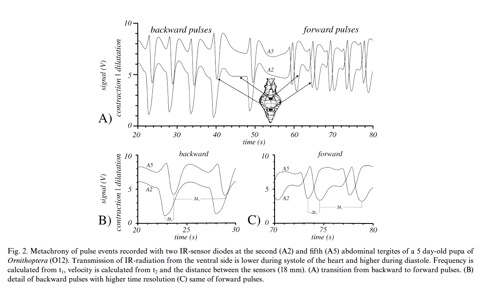In non-diapausing pupae of the two birdwing butterfly species Troides rhadamantus and Ornithoptera priamus (Lepidoptera, Papilionidae) heart activity and CO2 release rates were measured simultaneously within the initial half of pupal development. Heartbeat patterns in these pupae consist of three different types of activity: Continuous forward-pulse periods of different duration with a frequency range of about 0.25-0.52/s, continuous backward-pulse periods with lower frequencies (0.15-0.29/s) and intermittent backward-pulse periods when short series of three to 10 single heartbeats at frequencies of 0.12-0.35/s alternated with heart pauses of 2-10 min. CO2 release was discontinuous (CFO-type) from about four to 12 days after pupation in Troides rhadamantus and from about four to 18 days in Ornithoptera priamus. Mean CO2 release rates were very low in both species (10-30 nmol/g/ min). After this period, heart pauses occurred more frequently, probably indicating the onset of metamorphosis and the beginning partial histolysis of the heart. Infrared-optical and thermometrical measurements of heartbeat indicated that haemolymph transport within the dorsal vessel in forward direction is more effective than in backward direction. This is deduced from the higher heartbeat frequency and heartbeat amplitude of the forward pulsations. Results from ultrasonic doppler velocimetry suggest that haemolymph flow velocity is highest during the relatively long diastasis of 2-3 s (30-40 mm/s) while minimum particle speed (about 20 mm/s) is at the end of systole and the beginning of diastole. This would mean that haemolymph velocity is highest between two consecutive peristaltic waves. In contrast to the haemolymph velocity, the speed of the peristaltic wave measured with the infrared transmission technique was lower (about 8.4-22 mm/s in Troides, 10-23 mm/s in Ornithoptera) and remained constant during forward pulse periods. During backward beating the speed was lower (8-20 mm/s in Troides, 9-17 mm/s) in Ornithoptera, and decreased during backward pulse periods. During day two to seven in Troides and day three to nine in Ornithoptera, spiracular opening periods coincided with changes in heartbeat direction from backward to forward pulsations. A possible influence is the more efficient convective haemolymph mixing in the haemocoel during forward heartbeat. The mixing allows to bring the haemolymph in close contact with the tracheal system where the discharge of CO2 takes place. Heartbeat may therefore serve for shortening the diffusion pathways for a rapid transition into the tracheal system during the open period of the spiracles.

Metachrony of heart pulse events during heartbeat reversal measured by IR transmission in the pupa of the large butterfly Ornithoptera priamus

